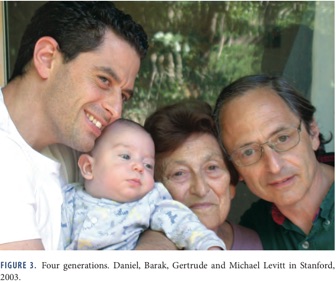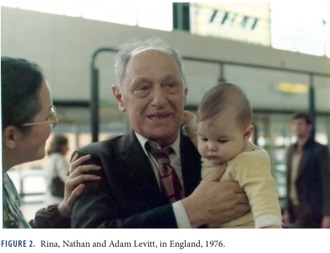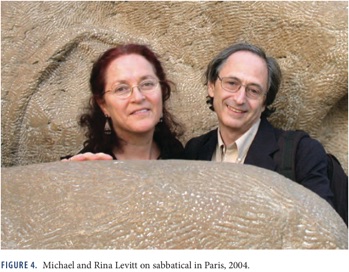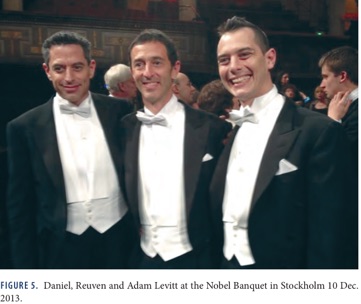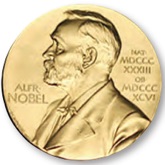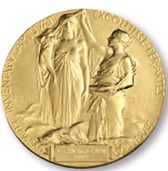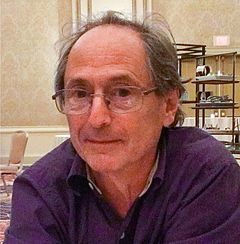Pretoria, South Africa

Michael Levitt
Michael Levitt
From Wikipedia, the free encyclopedia
Nobel Prize Laureate Michael Levitt during 2013 press conference in Stockholm
Born
9 May 1947 (age 67) [1]
Pretoria, South Africa
Citizenship
Fields
-
3Simulation of Mesoscale Molecular Dynamics[3]
Institutions
-
1King's College London (BSc)
-
2University of Cambridge (PhD)
Conformation analysis of proteins (1972)
Robert Diamond[4][5]
Doctoral students
-
1Gaurav Chopra
-
2Miri Hirshberg
-
3Chris Lee[6]
-
4David Hinds
-
5Enoch Huang
-
6Britt Park
-
7Adelene Sim
-
8Jerry Tsai
-
9Dahlia Weiss
-
10Yu Xia[7][8]
Other notable students
-
1(postdocs)
-
2Julie Bernauer
-
4Valerie Daggett[9]
-
5Mark Gerstein[10]
-
6Boris Fain
-
7Julian Gough[11]
-
8Xuhui Huang
-
9Chen Kaesar
-
10Peter Minary
-
11Leonid Pereyaslavets
-
12Tanya Raschke
-
13Abraham Samson
-
14Gunnar Schroeder
-
15Ram Samudrala[12]
-
16Junjie Zhang[5]
Notable awards
-
1FRS (2001)
-
2Member of the National Academy of Sciences
-
3EMBO member[13]
-
4Nobel Prize in Chemistry (2013)
Spouse
Rina[14]
Website
med.stanford.edu/profiles/Michael_Levitt
Michael Levitt at the Biophysical Society meeting, February 2013
Michael Levitt, FRS (born 9 May 1947) is an American-British-Israeli[15] biophysicist and a professor of structural biology at Stanford University, a position he has held since 1987.[16][17] Levitt received the 2013 Nobel Prize in Chemistry,[18] together with Martin Karplus and Arieh Warshel, for "the development of multiscale models for complex chemical systems".[19][20][21][22][23]
Education and early life
Michael Levitt was born in Pretoria, South Africa, to a Jewish family from Plungė, Lithuania; his father was Lithuanian and his mother was of Czech descent.[24] He attended Sunnyside Primary School and then Pretoria Boys High School between 1960 and 1962. The family moved to England when he was 15.[25] Levitt spent 1963 studying applied mathematics at the University of Pretoria.[26] He attended King's College London, graduating with a Bachelor of Science degree in Physics in 1967.[1][27]
In 1967, he visited Israel for the first time. Together with his Israeli wife, Rina,[14] a multimedia artist, he left to study at Cambridge, where his three children were born. In 1979, he returned to Israel and conducted research at the Weizmann Institute of Science in Rehovot, becoming an Israeli citizen in 1980. He served in the Israeli Defense Forces for six weeks in 1985. In 1986, he began teaching at Stanford, and since then has split his time between Israel and California.[28]
Career
Levitt was a PhD student in Computational Biology at Peterhouse, Cambridge, and was based at the Laboratory of Molecular Biology from 1968 to 1972, where he developed a computer program for studying the conformations of molecules that underpinned much of his later work.[29][30] In 1967, he was sent on behalf of the Laboratory of Molecular Biology at the University of Cambridge, to Israel, to work at the Weizmann Institute of Science, with Professor Shneior Lifson and a student of his – Arieh Warshel, of the Technion in Haifa. They were using computer modelling to understand the behaviour of biological molecules.[31]
He went on to gain a research fellowship at Gonville and Caius College, Cambridge.
From 1980 to 1987, he was Professor of Chemical Physics at Weizmann Institute of Science, Israel. Thereafter, he has served as Professor of Structural biology, at Stanford University, California.
-
•Royal Society Exchange Fellow, Weizmann Institute, Israel, 1967–68
-
•Staff Scientist, MRC Laboratory of Molecular Biology, Cambridge, 1973–80
-
•Professor of Chemical Physics, Weizmann Institute, 1980–87 (dept. chair 1980–83)
-
•Professor of Structural Biology, Stanford University, 1987–
Research
Levitt was one of the first researchers to conduct molecular dynamics simulations of DNA and proteins and developed the first software for this purpose.[32][33][34][35] He is currently well known for developing approaches to predict macromolecular structures, having participated in many Critical Assessment of Techniques for Protein Structure Prediction (CASP) competitions,[36] where he criticized molecular dynamics for inability to refine protein structures.[37] He has also worked on simplified representations of protein structure for analyzing folding and packing[38][39][40] and developing scoring systems for large-scale sequence-structure comparisons.[41][42] He has mentored many successful scientists, including Mark Gerstein and Ram Samudrala.[43][44][3] Cyrus Chothia was one of his colleagues.
Industrial collaboration
Levitt has served on the Scientific Advisory Boards of the following companies: Oplon Ltd, Cocrystal Discovery, StemRad, Ltd, and Cengent Therapeutics, Inc.
Awards and honors
Levitt received the 2013 Nobel Prize in Chemistry, together with Martin Karplus and Arieh Warshel, "for the development of multiscale models for complex chemical systems".[45]
Personal life
Levitt holds American, British and Israeli citizenship (he is the 6th Israeli to win the Nobel Prize in Chemistry in under a decade).[46][47] Levitt spends time every year in Israel, where his wife and children live.[48][49]
References
-
1^ Jump up to:
a b "LEVITT, Prof. Michael". Who's Who 2014. Who's Who (online Oxford University Press ed.). A & C Black an imprint of Bloomsbury Publishing plc. (subscription required) -
2
^ Levitt, M. (2001). "The birth of computational structural biology". Nature Structural Biology 8 (5): 392–393. doi:10.1038/87545. PMID 11323711. -
3
a b List of publications from Google Scholar -
4
^ Diamond, R.; Levitt, M. (1971). "A refinement of the structure of lysozyme". The Biochemical journal 125 (4): 92P. PMC 1178298. PMID 5144255. -
5
a b Michael Levitt academic genealogy and list of PhD & Postdoc trainees -
6
^ Michael Levitt at the Mathematics Genealogy Project -
9
^ Daggett, V.; Levitt, M. (1993). "Protein Unfolding Pathways Explored Through Molecular Dynamics Simulations". Journal of Molecular Biology 232 (2): 600–619. doi:10.1006/jmbi.1993.1414. PMID 7688428. -
10
^ Gerstein, M.; Levitt, M. (1997). "A structural census of the current population of protein sequences". Proceedings of the National Academy of Sciences of the United States of America 94 (22): 11911–11916. doi:10.1073/pnas.94.22.11911. PMC 23653. PMID 9342336. -
11
^ Pethica, R. B.; Levitt, M.; Gough, J. (2012). "Evolutionarily consistent families in SCOP: Sequence, structure and function". BMC Structural Biology 12: 27. doi:10.1186/1472-6807-12-27. PMC 3495643. PMID 23078280. -
12
^ Xia, Y.; Huang, E. S.; Levitt, M.; Samudrala, R. (2000). "Ab initio construction of protein tertiary structures using a hierarchical approach". Journal of Molecular Biology 300 (1): 171–185. doi:10.1006/jmbi.2000.3835. PMID 10864507. -
13
^ http://www.embo.org/embo-members/find-a-member.html Find an EMBO member -
15
^ 2 Israeli-Americans awarded Nobel Prize in chemistry 9 October 2013, 16:36, Ynet -
16
^ http://csb.stanford.edu/ Levitt Lab website -
17
^ http://csb.stanford.edu/levitt/ Lab Website Profile Page -
18
^ Van Noorden, R. (2013). "Modellers react to chemistry award". Nature 502 (7471): 280. doi:10.1038/502280a. -
19
^ Van Noorden, R. (2013). "Computer modellers secure chemistry Nobels". Nature. doi:10.1038/nature.2013.13903. -
20
^ "The Nobel Prize in Chemistry 2013" (Press release). Royal Swedish Academy of Sciences. 9 October 2013. Retrieved 9 October 2013. -
21
^ Chang, Kenneth (9 October 2013). "3 Researchers Win Nobel Prize in Chemistry". New York Times. Retrieved 9 October 2013. -
22
^ Official Nobelprize.org Michael Levitt site, interview and pictures -
23
^ Biography, from the Office of Scientific and Technical Information, United States Department of Energy -
24
^ Foreign Minister congratulates Litvak Levitt on winning Nobel Prize -
25
^ Nobel laureate Michael Levitt tells Haaretz: 'I still feel 16, so I have no ego’ -
26
^ Nobel laureate Michael Levitt recollects UP’s contribution to his scientific career, University of Pretoria -
27
^ http://csb.stanford.edu/levitt/2_Page_CV.html Michael Levitt CV -
28
^ Nobel laureate Michael Levitt tells Haaretz: 'I still feel 16, so I have no ego’ -
29
^ Levitt, Michael (1972). Conformation analysis of proteins (PhD thesis). University of Cambridge. -
30
^ "Nobel Prize in Chemistry for Peterhouse alumnus". Retrieved 11 October 2013. -
31
^ Computer chemists win Nobel prize By James Morgan and Jonathan Amos, BBC News, 9 October 2013 -
32
^ Chothia, C.; Lesk, A. M.; Tramontano, A.; Levitt, M.; Smith-Gill, S. J.; Air, G.; Sheriff, S.; Padlan, E. A.; Davies, D.; Tulip, W. R.; Colman, P. M.; Spinelli, S.; Alzari, P. M.; Poljak, R. J. (1989). "Conformations of immunoglobulin hypervariable regions". Nature 342 (6252): 877–883. Bibcode:1989Natur.342..877C. doi:10.1038/342877a0. PMID 2687698. -
33
^ Levitt, M.; Chothia, C. (1976). "Structural patterns in globular proteins". Nature 261 (5561): 552–558. Bibcode:1976Natur.261..552L. doi:10.1038/261552a0. PMID 934293. -
34
^ Warshel, A.; Levitt, M. (1976). "Theoretical studies of enzymic reactions: Dielectric, electrostatic and steric stabilization of the carbonium ion in the reaction of lysozyme". Journal of Molecular Biology 103 (2): 227–249. doi:10.1016/0022-2836(76)90311-9. PMID 985660. -
35
^ Levitt, M. (1976). "A simplified representation of protein conformations for rapid simulation of protein folding". Journal of Molecular Biology 104 (1): 59–107. doi:10.1016/0022-2836(76)90004-8. PMID 957439. -
36
^ Chopra, G.; Kalisman, N.; Levitt, M. (2010). "Consistent refinement of submitted models at CASP using a knowledge-based potential". Proteins: Structure, Function, and Bioinformatics 78 (12): n/a–n/a. doi:10.1002/prot.22781. PMC 2911515. PMID 20589633. -
37Jump up
^ CASP participants usually did not try to use MD to avoid "a central embarrassment of molecular mechanics, namely that energy minimization or molecular dynamics generally leads to a model that is less like the experimental structure", Koehl, P; Levitt, M (1999). "A brighter future for protein structure prediction". Nature Structural Biology 6 (2): 108–11. doi:10.1038/5794. PMID 10048917. -
38
^ Hinds, D. A.; Levitt, M. (1994). "Exploring conformational space with a simple lattice model for protein structure". Journal of molecular biology 243 (4): 668–682. doi:10.1016/0022-2836(94)90040-X. PMID 7966290. -
39
^ Park, B.; Levitt, M. (1996). "Energy Functions that Discriminate X-ray and Near-native Folds from Well-constructed Decoys". Journal of Molecular Biology 258 (2): 367–392. doi:10.1006/jmbi.1996.0256. PMID 8627632. -
40
^ Gerstein, M.; Tsai, J.; Levitt, M. (1995). "The Volume of Atoms on the Protein Surface: Calculated from Simulation, using Voronoi Polyhedra". Journal of Molecular Biology 249 (5): 955–966. doi:10.1006/jmbi.1995.0351. PMID 7540695. -
41
^ Levitt, M.; Gerstein, M. (1998). "A unified statistical framework for sequence comparison and structure comparison". Proceedings of the National Academy of Sciences of the United States of America 95 (11): 5913–5920. doi:10.1073/pnas.95.11.5913. PMC 34495. PMID 9600892. -
42
^ Brenner, S. E.; Koehl, P.; Levitt, M. (2000). "The ASTRAL compendium for protein structure and sequence analysis". Nucleic acids research 28 (1): 254–256. doi:10.1093/nar/28.1.254. PMC 102434. PMID 10592239. -
44
^ Michael Levitt from the Scopus bibliographic database. -
45
^ http://www.nobelprize.org/nobel_prizes/chemistry/laureates/2013/press.pdf -
46
^ Tiny Israel a Nobel heavyweight, especially in chemistry -
47
^ [1] By Haviv Rettig Gur, 9 October 2013, Times of Israel -
48
^ Two Israeli scientists who emigrated to U.S. win Nobel Prize in Chemistry Haaretz, by Ido Efrati, 9 October 2013 -
49
^ Nobel laureate: I didn't get tenure in Israel Yitzhak Benhorin, Washington, Ynet, 9 October 2013
-
•
Awards
Preceded by
Nobel Prize in Chemistry laureate
2013
With: Martin Karplus
Most recent
Laureates of the Nobel Prize in Chemistry
2013 Nobel Prize laureates
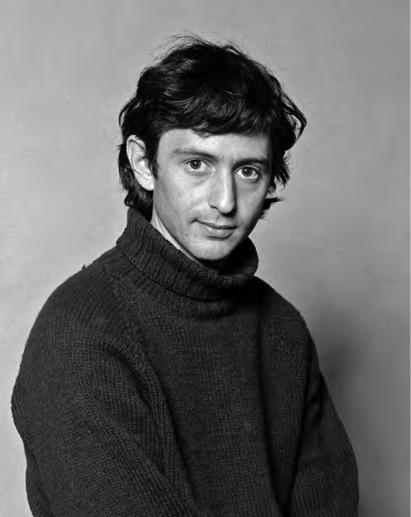
FIGURE1. MichaelLevitt’sofficialphotographtakenbyKenHarveyattheMRCLaboratory
of Molecular Biology in 1968 or 1969. He was then 21
